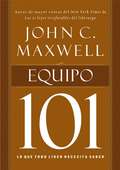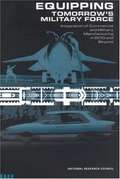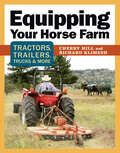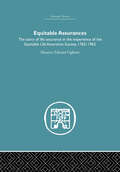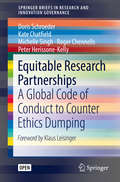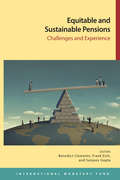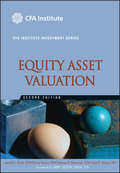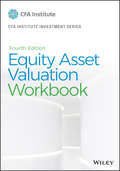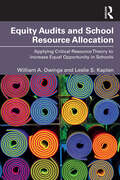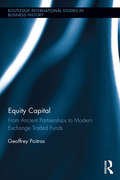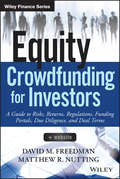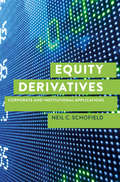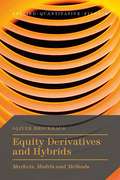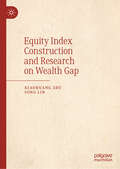- Table View
- List View
Equipo 101: Lo que todo líder necesita saber
by John MaxwellOtro gran librito repleto de sabiduría e instrucción para añadir a la exitosa serie Maxwell 101. John C. Maxwell cree que «trabajar en equipo se encuentra en el corazón de los grandes logros». La pregunta no es si los equipos tienen valor. La pregunta es si nosotros reconocemos ese hecho y nos convertimos en mejores trabajadores en equipo. En Equipo 101, Maxwell hace uso de la sabiduría sobre liderazgo de sus libros Las 17 leyes incuestionables del trabajo en equipo, El talento nunca es suficiente, Desarrolle los líderes que están alrededor de usted, Líder de 360°, Cómo ganarse a la gente, Las 21 leyes irrefutables del liderazgo y Las 17 cualidades esenciales de un jugador de equipo. Esta estrategia poderosa y concisa puede ayudar a líderes a crear un ambiente que produzca victoria y satisfacción a todo el equipo.
Equipping Tomorrow's Military Force: Integration of Commercial and Military Manufacturing in 2010 and Beyond
by National Research CouncilInformation on the Integration of Commercial and Military Manufacturing in 2010 and Beyond
Equipping Your Horse Farm: Tractors, Trailers, Trucks & More
by Cherry Hill Richard KlimeshRunning a horse farm requires acquiring, operating, and maintaining an assortment of heavy machinery. This practical guide shows you how to expertly equip your operation with trucks, trailers, tractors, and more. Learn how to compare models, select machines appropriate to your needs, troubleshoot problems, and work with attachments like loaders, disc harrows, and manure spreaders. Using the right machinery will help you work more efficiently, save you money, and leave you more time to spend with your horses.
Equitable Assurances: The Story of Life Assurance in the Experience of The Equitable LIfe Assurance Society 1762-1962
by Maurice OgbornThe original establishment of life assurance upon a sound basis was largely the achievement of The Society for Equitable Assurances on Lives and Survivorships (now known as The Equitable Life Assurance Society and still affectionately called the 'Old Equitable'), and of the men who served her. Old Equitable was the first life assurance society to grant long-term contracts for either a stated period or the whole of life, with premiums calculated according to age and type of assurance. Published in 1962 to mark this Society's bicentenary, this book charts its long history in a way that will interest not only those actually engaged in the assurance business, but any intelligent policy holder to whom perhaps the mechanics of life assurance is still a mystery. This book traces the development of life assurance from untried theory into established practice, through the interplay of ideas of many individuals. Their activities, ranging far beyond the quiet walls of a life office, are part of the stuff of history. It tells the story of how James Dodson's vision of mutual life assurance became realized in the pioneer 'experiment' of the Equitable.
Equitable Research Partnerships: A Global Code of Conduct to Counter Ethics Dumping (SpringerBriefs in Research and Innovation Governance)
by Doris Schroeder Roger Chennells Kate Chatfield Peter Herissone-Kelly Michelle SinghThis open access book offers insights into the development of the ground-breaking Global Code of Conduct for Research in Resource-Poor Settings (GCC) and the San Code of Research Ethics. Using a new, intuitive moral framework predicated on fairness, respect, care and honesty, both codes target ethics dumping – the export of unethical research practices from a high-income setting to a lower- or middle-income setting. The book is a rich resource of information and argument for any research stakeholder who opposes double standards in research. It will be indispensable for applicants to European Union framework programmes, as the GCC is now a mandatory reference document for EU funding.
Equitable and Sustainable Pensions: Challenges and Experience
by Sanjeev Gupta Benedict Clements Frank EichA report from the International Monetary Fund.
Equity Asset Valuation
by Abby Cohen Elaine Henry Jerald E. Pinto John D. Stowe Thomas R. RobinsonA comprehensive look at the equity valuation processWith the Second Edition of Equity Asset Valuation, the distinguished team of Jerald Pinto, Elaine Henry, Thomas Robinson, and John Stowe, fully update information associated with this important discipline. Blending theory with practice, they detail the contemporary techniques used to determine the intrinsic value of an equity security, and show you how to successfully apply these techniques in both foreign and domestic markets.Unlike alternative works in this field, the Second Edition of Equity Asset Valuation clearly integrates finance and accounting concepts into the discussion-providing the evenness of subject matter treatment, consistency of notation, and continuity of topic coverage that is so critical to the learning process.Addresses essential issues in this arena, including the equity valuation process, discounted dividend valuation, free cash flow valuation, and residual income valuationEach author brings his own unique experiences and perspectives to the equity analysis processDistills the knowledge, skills, and abilities you need to succeed in today's fast-paced financial environmentCompanion Workbook also availableValuable for classroom study, self-study, and general reference, this book contains clear, example-driven coverage of many of today's most important valuation issues.
Equity Asset Valuation (CFA Institute Investment Series #121)
by Jerald PintoNavigate equity investments and asset valuation with confidence Equity Asset Valuation, Fourth Edition blends theory and practice to paint an accurate, informative picture of the equity asset world. The most comprehensive resource on the market, this text supplements your studies for the third step in the three-level CFA certification program by integrating both accounting and finance concepts to explore a collection of valuation models and challenge you to determine which models are most appropriate for certain companies and circumstances. Detailed learning outcome statements help you navigate your way through the content, which covers a wide range of topics, including how an analyst approaches the equity valuation process, the basic DDM, the derivation of the required rate of return within the context of Markowitz and Sharpe's modern portfolio theory, and more.
Equity Asset Valuation Workbook (CFA Institute Investment Series #121)
by Jerald PintoEquity Asset Valuation Workbook, Fourth Edition provides the key component of effective learning: practice. This companion workbook conveniently aligns with the text chapter-by-chapter, provides brief chapter summaries to refresh your memory on key points before you begin working, and explicitly lays out the learning objectives so you understand the “why” of each problem. These features reinforce essential theories and their practical application, assist you in gaining proficiency in the core concepts behind these theories, and accurately determine when and how to implement them. Those who self study will find solutions to all exercise problems. This workbook lets you: Refresh your memory with succinct chapter summaries Enhance your understanding with topic-specific practice problems Work toward explicit chapter objectives to internalize key information Practice important techniques with real-world applications For everyone who wants a practical route to mastering the general analysis of stock shares held by individuals and funds, Equity Asset Valuation Workbook, Fourth Edition lives up to its reputation for clarity and world-class practice based on actual scenarios investors face every day.
Equity Audits and School Resource Allocation: Applying Critical Resource Theory to Increase Equal Opportunity in Schools
by Leslie S. Kaplan William A. OwingsEquity Audits and School Resource Allocation explores how to apply Critical Resource Theory (CReT) to conduct school equity audits, ultimately preparing educational leaders to find equity disparities, engage in more equitable resource allocation in their schools, and improve equal educational opportunity for every student. With case study scenarios woven throughout the book, the authors explore key equity factors, including per-pupil expenditures, poverty, teacher and principal quality, program equity, and achievement equity. They also walk through the process of implementing the 5-step CReT equity audit within a school district or school at any level. Owings and Kaplan also describe the communication and interpersonal factors that equity advocates will need to leverage to gain community support for equity process, considering the data, and rethinking their policies and practices. In today’s education context, the problems of equitably funding public schools and allocating learning resources to generate more equal opportunities and higher outcomes for traditionally underserved children are particularly relevant. This important book is designed for course use in leadership preparation programs, for practicing principals and superintendents, and for educational leadership scholars.
Equity Bank: Challenging a Giant
by Lauren H. Cohen Spencer C. N. Hagist Michael ChitaviEquity Bank and CEO Dr. James Mwangi must find a way to advance from their hard-fought ascension to second largest bank in Kenya by toppling financial giant Safaricom. Doing so means developing a new strategy and tackling technological frontiers no institution in the country has yet faced.
Equity Bank: Charting the Future
by Lauren H. Cohen Spencer C. N. Hagist Michael ChitaviAfter climbing the ranks among Kenya's financial institutions from 66th to 1st, and toppling a quarter of the market share held by mobile money giant Safaricom, CEO James Mwangi must now guide Equity Bank into its next stage of development beyond "Equity 3.0." Should he continue to chip away at the substantial hold Safaricom still has over the industry, or should he branch out into completely new areas that the company has never dealt with before? The former would mean a long and grueling fight, but the latter could spell disaster if fresh ventures go awry. Is the company's innovative approach on its homefield evidence of a deeper penchant for ingenuity overall, or was Mwangi simply in the right place at the right time with its landmark MVNO Equitel?
Equity Capital: From Ancient Partnerships to Modern Exchange Traded Funds (Routledge International Studies in Business History)
by Geoffrey PoitrasCapitalism is historically pervasive. Despite attempts through the centuries to suppress or control the private ownership of commercial assets, production and trade for profit has survived and, ultimately, flourished. Against this backdrop, accounting provides a fundamental insight: the ‘value’ of physical and intangible capital assets that are used in production is identically equal to the sum of the debt liabilities and equity capital that are used to finance those assets. In modern times, this appears as the balance sheet relationship. In determining the ‘value’ of items on the balance sheet, equity capital appears as a residual calculated as the difference between the ‘value’ of assets and liabilities. Through the centuries, the organization of capitalist activities has changed considerably, dramatically impacting the methods used to value, trade and organize equity capital. To reflect these changes, this book is divided into four parts that roughly correspond to major historical changes in equity capital organization. The first part of this book examines the rudimentary commercial ventures that characterized trading for profit from ancient times until the contributions of the medieval scholastics that affirmed the moral value of equity capital. The second part deals with the evolution of equity capital organization used in seaborne trade of the medieval and Renaissance Italian city states and in the early colonization ventures of western European powers and ends with the emergence in the market for tradeable equity capital shares during the 17th century. The third part begins with the 1719-1720 Mississippi scheme and South Sea bubbles in northern Europe and continues to cover the transition from joint stock companies to limited liability corporations with autonomous shares in England, America and France during the 19th century. This part ends with a fundamental transition in the social conception of equity capital from a concern with equity capital organization to the problem of determining value. The final part is concerned with the evolving valuation and management of equity capital from the 1920s to the present. This period includes the improvement corporate accounting for publicly traded shares engendered by the Great Depression that has facilitated the use of ‘value investing’ techniques and the conflicting emergence of portfolio management methods of modern Finance. Equity Capital is aimed at providing material relevant for academic presentations of equity valuation history and methods, and is targeted at researchers, academics, students and professionals alike.
Equity Compensation in Startup Ventures
by Ramana Nanda Robert White Stephanie PuzioSetting equitable and "market" level compensation for founders and early employees of startups is one of the most important elements of a new venture. It is not only central to attract and retain the best human capital for the startup, but is critical to align incentives between investors and management. This note provides a framework to think about compensation in startup ventures and is intended for entrepreneurs thinking about starting a venture, as well as for employees looking to join a young high-potential startup.
Equity Crowdfunding for Investors
by David M. Freedman Matthew R. Nuttingent offerings, andhow to find the best advice and information available.
Equity Crowdfunding for SMEs: An Alternative Financing Tool (SIDREA Series in Accounting and Business Administration)
by Giuseppe ModaffariThis book focuses on the relevance of equity-side innovative financial tools for SMEs in overcoming financial threats. Scholars identify difficulties in the financial sphere as the main causes of SME mortality. Such problems do not allow them to reach sustainable growth. It thus becomes critical to have the best knowledge of innovative financial tools to overcome financial constraints. By exploring the origin of financial needs, the book aims to observe how innovative equity-side financing tools, particularly equity crowdfunding, contribute to the SME dimension. The work outlines the main development factors, observing equity-crowdfunding’s effect on the rate at which SMEs reach sustainable total development (STD). Moreover, outlining the fundamentals of the main theories developed on financing choices, the work concludes with a systematic literature analysis on equity crowdfunding, highlighting the main features that currently increase scholars’ interest in the topic.
Equity Crowdfunding in Sports Clubs: Consumer-Oriented Strategic Marketing (Routledge Research in Sport Business and Management)
by Szczepan KościółekThis is the first book to focus on crowdfunding in sport. Crowdfunding is an important new financial instrument that is becoming more popular with sports organisations, and this book examines the research evidence for crowdfunding and considers how it might be successfully implemented. Presenting international cases and data, including from European football, the book explains how crowdfunding campaigns have to be fully integrated with strategic marketing plans and require a solid understanding of the needs and motivations of potential investors, consumers, and fans. The book sets out a theoretical framework for applying strategic marketing in the context of crowdfunding in sports clubs, introduces the key characteristics of the sports crowdfunding market and funders’ behaviours in the crowdfunding campaigns of sports clubs, examines the market segments of the campaigns’ funders, and presents recommendations for developing marketing-mix programs to target them. This is important reading for any researcher, advanced student, or practitioner with an interest in sport business, sport marketing, sport finance, consumer behaviour in sport, or entrepreneurship, innovation, or technology in sport.
Equity Crowdfunding: Essays about the Scientific Development and the Investor Perspective
by Kazem Mochkabad KhoramchahiBecause of the subprime mortgage crisis in 2008, the challenges of securing necessary external capital have become more significant for young ventures. In this realm, equity crowdfunding has evolved into the most promising financing alternative for entrepreneurs and received worldwide attention. By focusing on three subsequent research questions, this book aims to contribute to the ongoing scientific discussion of equity crowdfunding. First, it reveals fruitful future research avenues by providing a systematic overview of the development of equity crowdfunding research. Second, it sheds light on the so far less explored investor perspective and analyzes the decision-making process of equity crowdfunding investors. Third, based on a multi-method approach, the questions of how equity crowdfunding investors evaluate radically innovative ventures and how radically innovative ventures can establish venture legitimacy are explored.
Equity Derivatives
by Laurent Nguyen-Ngoc Gero Schindlmayr Marcus Overhaus Frank Mao Thomas Knudsen Andrew FerrarisWritten by the quantitative research team of Deutsche Bank, the world leader in innovative equity derivative transactions, this book acquaints readers with leading-edge thinking in modeling and hedging these transactions. Equity Derivatives offers a balanced, integrated presentation of theory and practice in equity derivative markets. It provides a theoretical treatment of each new modeling and hedging concept first, and then demonstrates their practical application. The book covers: the newest and fastest-growing class of derivative instruments, fund derivatives; cutting-edge developments in equity derivative modeling; new developments in correlation modeling and understanding volatility skews; and new Web-based implementation/delivery methods.Marcus Overhaus, PhD, Andrew Ferraris, DPhil, Thomas Knudsen, PhD, Frank Mao, PhD, Ross Milward, Laurent Nguyen-Ngoc, PhD, and Gero Schindlmayr, PhD, are members of the Quantitative Research team of Deutsche Bank's Global Equity Division, which is based in London and headed by Dr. Overhaus.
Equity Derivatives
by Neil C SchofieldThis book provides thorough coverage of the institutional applications of equity derivatives. It starts with an introduction on stock markets' fundamentals before opening the gate on the world of structured products. Delta-one products and options are covered in detail, providing readers with deep understanding of the use of equity derivatives strategies. The book features most of the traded payoffs and structures and covers all practical aspects of pricing and hedging. The treatment of risks is performed in a very intuitive fashion and provides the reader with a great overview of how dealers approach such derivatives. The author also delivers various common sensical reasons on which models to use and when. By discussing equity derivatives in a practical, non-mathematical and highly intuitive setting, this book enables practitioners to fully understand and correctly structure, price and hedge these products effectively, and stand strong as the only book in its class to make these equity-related concepts truly accessible.
Equity Derivatives Explained
by Mohamed BouzoubaaA succinct book that provides readers with all they need to know about the equity derivatives business. It deals with vanilla equity products, their usage, structuring and their risk management. The author efficiently bridges the gap between theory and practice, constantly linking risk management tools with specific business objectives.
Equity Derivatives and Hybrids: Markets, Models And Methods (Applied Quantitative Finance Ser.)
by Oliver BrockhausSince the development of the Black-Scholes model, research on equity derivatives has evolved rapidly to the point where it is now difficult to cut through the myriad of literature to find relevant material. Written by a quant with many years of experience in the field this book provides an up-to-date account of equity and equity-hybrid (equity-rates, equity-credit, equity-foreign exchange) derivatives modeling from a practitioner's perspective. The content reflects the requirements of practitioners in financial institutions: Quants will find a survey of state-of-the-art models and guidance on how to efficiently implement them with regards to market data representation, calibration, and sensitivity computation. Traders and structurers will learn about structured products, selection of the most appropriate models, as well as efficient hedging methods while risk managers will better understand market, credit, and model risk and find valuable information on advanced correlation concepts. Equity Derivatives and Hybrids provides exhaustive coverage of both market standard and new approaches, including: -Empirical properties of stock returns including autocorrelation and jumps -Dividend discount models -Non-Markovian and discrete-time volatility processes -Correlation skew modeling via copula as well as local and stochastic correlation factors -Hybrid modeling covering local and stochastic processes for interest rate, hazard rate, and volatility as well as closed form solutions -Credit, debt, and funding valuation adjustment (CVA, DVA, FVA) -Monte Carlo techniques for sensitivities including algorithmic differentiation, path recycling, as well as multilevel. Written in a highly accessible manner with examples, applications, research, and ideas throughout, this book provides a valuable resource for quantitative-minded practitioners and researchers.
Equity Home Bias in International Finance: A Place-Attachment Perspective (Banking, Money and International Finance)
by Kavous ArdalanThis book provides a comprehensive and critical analysis of research outcomes on the equity home bias puzzle – that people overinvest in domestic stocks relative to the theoretically optimal investment portfolio. It introduces place attachment – the bonding that occurs between individuals and their meaningful environments – as a new explanation for equity home bias, and presents a philosophically multi-paradigmatic view of place attachment. For the first time, a comprehensive and up-to-date review of the extant literature is provided, demonstrating that place attachment is a contributing factor to 22 different topics in which variations of home bias are present. The author also analyses the social-psychological underpinnings of place attachment, and considers the effect of multi-culturalism on the future of equity home bias. The book’s unique approach discusses the issues in conceptual terms rather than through data and statistical methods. This multi- and inter-disciplinary book is an invaluable resource for graduate students and researchers interested in economics, finance, philosophy, and/or methodology, introducing them to a new line of research.
Equity Index Construction and Research on Wealth Gap
by Xiaohuang Zhu Song LinThis book constructs a Chinese Social Equality Index–the Mongoose Social Equality Index–with the wealth gap index as its core, and the legal equality index, the socio-cultural equality index, and the financial equality index as its supplement. The book focuses on the influence of the wealth gap on economic and social issues. Empirical research shows that there are three turning points in the influence of the wealth gap index on economic growth: discrepancy turning point, golden turning point and destructive turning point. Based on the latest data,the current expected wealth gap index in China has surpassed the destructive point. This means that wealth brought about by economic growth will largely go to the rich, which aggravates inequality and even brings forth a potential economic recession. Meanwhile, the index also indicates that, as the Chinese economy develops, social equality has been on a noticeable decline. This book will be of interest to economists, China watchers, and political scientists
